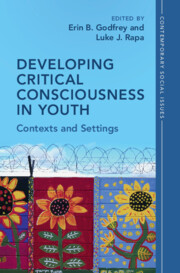Book contents
- Developing Critical Consciousness in Youth
- Contemporary Social Issues Series
- Developing Critical Consciousness in Youth
- Copyright page
- Dedication
- Contents
- Figures
- Tables
- Contributors
- Acknowledgments
- Introduction
- Part I Pedagogical, Curricular, and School-Based Contexts
- Part II Extracurricular Contexts
- Part III Societal Contexts
- Index
- References
Part II - Extracurricular Contexts
Published online by Cambridge University Press: 11 May 2023
- Developing Critical Consciousness in Youth
- Contemporary Social Issues Series
- Developing Critical Consciousness in Youth
- Copyright page
- Dedication
- Contents
- Figures
- Tables
- Contributors
- Acknowledgments
- Introduction
- Part I Pedagogical, Curricular, and School-Based Contexts
- Part II Extracurricular Contexts
- Part III Societal Contexts
- Index
- References
Summary

- Type
- Chapter
- Information
- Developing Critical Consciousness in YouthContexts and Settings, pp. 91 - 192Publisher: Cambridge University PressPrint publication year: 2023



